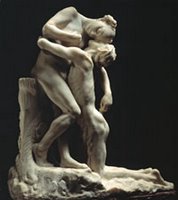Camille Claudel

The older sister of poet Paul Claudel, Camille Claudel (born on this day in 1864 in Fere, France) showed talent in clay modeling at an early age, and her indulgent father sought to guarantee her an education in the arts, enrolling her at the Academie Colarossi, one of the few art academies open to women. In her teens she also began receiving weekly informal lessons from local sculptor Alfred Boucher.
 When Boucher left for Italy in 1883, Auguste Rodin (by that time already a celebrated sculptor) took over Claudel's weekly lessons. In a modern echo of the Heloise and Abelard affair, Rodin (the teacher, age 43) and Claudel (the student, age 19) became lovers; but in the 19th century version of the familiar tale, the lovers stayed together for 15 years, even though Rodin had a long-term relationship and a son with Rose Beuret. Claudel became Rodin's studio assistant, helping Rodin produce some of his finest work (including assisting on Rodin's Burghers of Calais, 1895, and Gates of Hell, 1900) and more or less sacrificing her own career in the process.
When Boucher left for Italy in 1883, Auguste Rodin (by that time already a celebrated sculptor) took over Claudel's weekly lessons. In a modern echo of the Heloise and Abelard affair, Rodin (the teacher, age 43) and Claudel (the student, age 19) became lovers; but in the 19th century version of the familiar tale, the lovers stayed together for 15 years, even though Rodin had a long-term relationship and a son with Rose Beuret. Claudel became Rodin's studio assistant, helping Rodin produce some of his finest work (including assisting on Rodin's Burghers of Calais, 1895, and Gates of Hell, 1900) and more or less sacrificing her own career in the process. Although Rodin's warm, naturalistic style influenced Claudel in her work, wrenching her away from the academic, classical style she clung to in her youth, her solo work also inspired Rodin, her Jeune Fille a la Gerbe (1887) being a precursor, for example, for Rodin's Galatea. Professional jealousy apparently led to Rodin's emotional distance from Claudel; and in the early 1890s as Claudel began to realize that Rodin would never leave Rose for her, her work began to take on a style quite apart from the influence of Rodin, one more cognizant of art nouveau currents, concerning itself with the elegant play of light on smooth surfaces.
Her final separation from Rodin in 1898 severely wounded Claudel, providing the inspiration for her L'Age Mur (1895-1907), a depiction of Claudel begging Rodin on her knees not to leave. On her own at 34, she had to battle against the prejudices afflicting female artists as well as critics who believed that the presence of Rodin was the best of her art; unfortunately, the combination of poverty and her anguish over Rodin took its toll on her mental health. In 1906 she attempted to destroy her sculptures, and after 1913 she was confined to a series of mental institutions for the rest of her life. She died in 1943.
Her affair with Rodin was the basis for a play by Henrik Ibsen, When We Dead Awake (1899) as well as an acclaimed film, Camille Claudel (1988; starring Isabelle Adjani, with Gerard Depardieu as Rodin).
Labels: Painting and Sculpture, Trailblazing Women





0 Comments:
Post a Comment
Subscribe to Post Comments [Atom]
<< Home